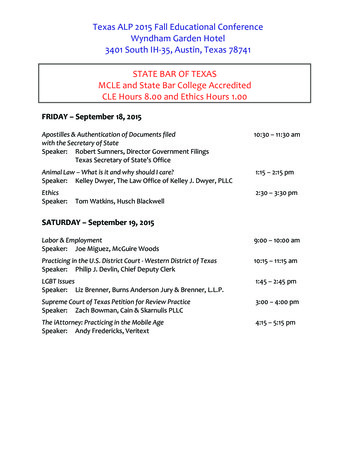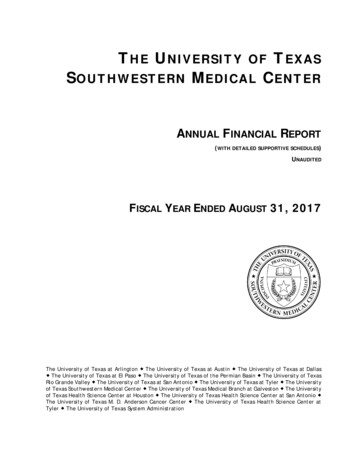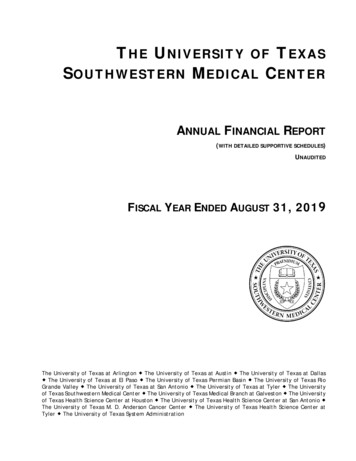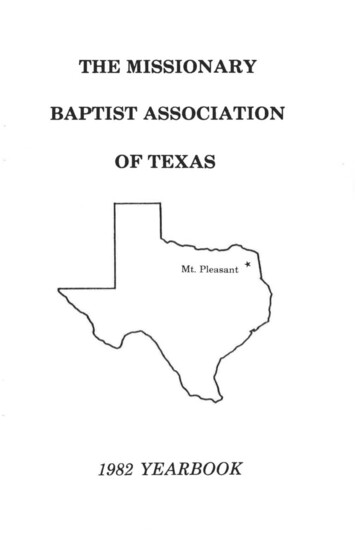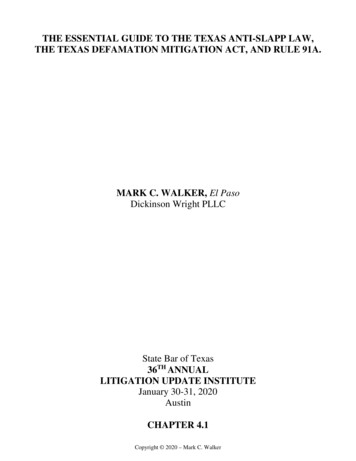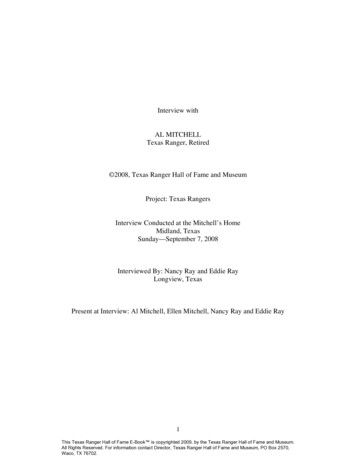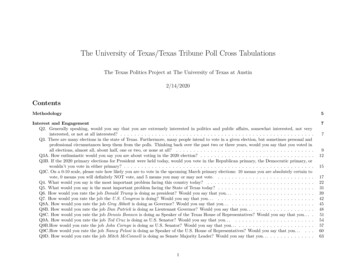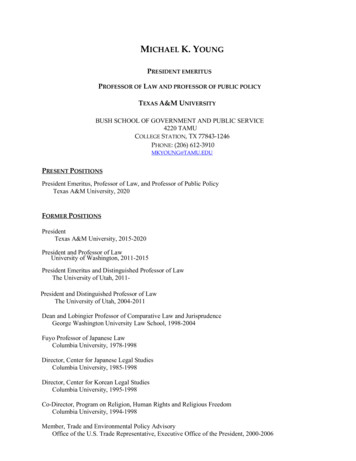
Transcription
MICHAEL K. YOUNGPRESIDENT EMERITUSPROFESSOR OF LAW AND PROFESSOR OF PUBLIC POLICYTEXAS A&M UNIVERSITYBUSH SCHOOL OF GOVERNMENT AND PUBLIC SERVICE4220 TAMUCOLLEGE STATION, TX 77843-1246PHONE: (206) 612-3910MKYOUNG@TAMU.EDUPRESENT POSITIONSPresident Emeritus, Professor of Law, and Professor of Public PolicyTexas A&M University, 2020FORMER POSITIONSPresidentTexas A&M University, 2015-2020President and Professor of LawUniversity of Washington, 2011-2015President Emeritus and Distinguished Professor of LawThe University of Utah, 2011President and Distinguished Professor of LawThe University of Utah, 2004-2011Dean and Lobingier Professor of Comparative Law and JurisprudenceGeorge Washington University Law School, 1998-2004Fuyo Professor of Japanese LawColumbia University, 1978-1998Director, Center for Japanese Legal StudiesColumbia University, 1985-1998Director, Center for Korean Legal StudiesColumbia University, 1995-1998Co-Director, Program on Religion, Human Rights and Religious FreedomColumbia University, 1994-1998Member, Trade and Environmental Policy AdvisoryOffice of the U.S. Trade Representative, Executive Office of the President, 2000-2006
Senior AdvisorQuinn, Emanuel, Urquhart, Oliver & Hedges, 2002-2006Chair, U.S. Commission on International Religious Freedom, 2001-2002; 2003-2004Vice-chair, U.S. Commission on International Religious Freedom, 2002-2003Member, U.S. Commission on International Religious Freedom, 1998-2005Member, Committee on International Judicial RelationsJudicial Conference of the United States, 1999-2005Member, Brown v. Board of Education 50th Anniversary Commission, 2003-20041999-2001U.S. Air Force Academy, Board of VisitorsMember1995-1998POSCO Research InstituteFellow1996U.S. House of RepresentativesSelect Subcommittee on Transfers of Iranian Arms to Bosnian MuslimsCounsel1992-1993U.S. Department of StateAmbassador for Trade and Environmental Affairs1991-1993U.S. Department of StateDeputy Under Secretary for Economic and Agricultural Affairs1989-1991U.S. Department of StateDeputy Legal Adviser1986-1989Skadden, Arps, Slate, Meagher & FlomOf Counsel1984-1986Milbank, Tweed, Hadley & McCloyOf CounselHONORS AND AWARDSDistinguished Service Award, L.D.S. International Association, 2011International Leader of the Year (presented by the World Trade Association of Utah), 2008U.S.-China Educational Collaboration Leadership Award, Chinese Association for Science andTechnology - USA, 2008Knighted by His Royal Highness of Portugal into the Order of St. Michael of the Wing, 2007Helping Hands Award, Utah Youth Village, 2006MICHAEL K. YOUNG, CURRICULUM VITAE2
Award in Recognition of Excellence in the Promotion of International Religious Freedom, The Church ofJesus Christ of Latter-day Saints, 2006Distinguished Service Award, J. Reuben Clark Society, Los Angeles Chapter, 2006Award for Distinguished Service in Promoting Religious Freedom, The International Center for LawReligious Studies at Brigham Young University, 2005Communicator of the Year Award, Utah Chapters of the Public Relations Society of America and theInternational Association of Business Communicators, 2005Award of Excellence in Education, Utah Hispanic Chamber of Commerce, 2005Award for Excellence in Ethics, Utah Valley State University, 2004Honored Alumni of the Year, College of Humanities, Brigham Young, 1995PROFESSIONAL ACTIVITIESUniversity Research Association, Chair Council of Presidents, 2018-2020Rocky Vista University College of Osteopathic Medicine Southern Utah Exec Advisory Council, Member,2016Homeland Security Academic Advisory Council, Dept. of Homeland Security, Member, 2016Greater Houston Partnership, Board Member, 2016Washington State Economic Development Commission, Member, 2012-2015City of Seattle Economic Development Commission, Member, 2013-2015U.S. Commission on International Religious Freedom, Chair, 2001-2002, 2003-2004; Vice-chair, 1999-2000Council on Foreign Relations, MemberAmerican Bar Foundation, Fellow, 1999-PresentHarvard Law Review Board of Overseers, Member, 2008-PresentAmerican Council on Education Commission on International Initiatives, 2007-PresentTrees Fellowships at the Grand Canyon Trust Advisory Council, Member, 2007-2011Judicial Conference of the United States, Committee on International Judicial Relations, Member, 1999-2005Project on Religion, Rights and Religious Freedom: An International Exchange and Research Project,Columbia University, Director, 1994-1998Project on German and Korean Unification, Columbia University, Centrum fur AngewandtePolitikforschung, and the Korean Economic Research Institute, Member, 1997-2000MICHAEL K. YOUNG, CURRICULUM VITAE3
Japan Society Public Affairs Programs Advisory Committee, 1995-1999World Trade Organization, Consultant, 1997-1998Japan Society Professional Fellows Selection Committee, Member, 1994-2004U.S. Department of State, Consultant, 1993-1995The Japan Business Law Journal, Board of Editors, 1979-1981Doing Business in Japan (Matthew-Bender), Board of EditorsAssociation of the Bar of the City of New York, Committee on Federal Legislation, Member, 1981-1983Association of American Law Schools, Section on Graduate Studies, Chairman, 1989-1990Association of American Law Schools, Section on Comparative Law, Chairman, 1987-1988Yale Law School, Lecture-in-Law, 1986-1987Admission to the Bar – California and New YorkPROFESSIONAL ASSOCIATION 018-2020Southeastern Conference Presidents and ChancellorsWorldwide Universities Network (WUN)Association of American UniversitiesAssociation of Pacific Rim UniversitiesAssociation of Public and Land-grant UniversitiesAssociation of Governing Boards of Colleges and UniversitiesPac-12 Conference Chief Executive OfficersUniversity Research Association, Chair, Board of AdvisorsCOMMITTEE AND BOARD 2008-20112006-20112004-20112004-2011Greater Houston PartnershipWashington Council on AerospaceTechnology AllianceUniversity of Washington Medicine BoardWilliam D. Ruckelshaus Center, Advisory BoardSeattle Community Development RoundtableGlobal Health NexusProsperity Partnership, Co-chairUW Advisory Committee on Real EstateUW Investment Advisory CommitteeSkyWest, Inc., Board of DirectorsThe East-West Center Board of GovernorsThe Craig H. Neilsen Foundation Board of DirectorsNational Campaign to Stop Violence, Board of DirectorsThe Herbert I. And Elsa B. Michael Foundation Advisory BoardMICHAEL K. YOUNG, CURRICULUM VITAE4
2004-2011The Tanner Lectures on Human Values Board of TrusteesUndergraduate:Brigham Young University, Provo, UtahB.A., Summa Cum Laude with Highest Honors, 1973Degree: Political Science and JapaneseLegal:Harvard Law School, Cambridge, MassachusettsJ.D., Magna Cum Laude, 1976Activities:Harvard Law Review, Board of Eds., 1974-75Harvard Law Review, Note Editor, 1975-76Japanese Legal Documents SeminarEast Asian Legal Studies ProgramScholarships:National Defense Foreign Language Fellowship (NDEA Title VI) to study Japanese inconjunction with Law School courses, 1975-1976EDUCATIONACADEMIC HONORSBrigham YoungUniversity:Summa Cum LaudeHighest Honors designation in Honors ProgramEdwin O. Hinckley Social Science Scholarship, 1972-1973Elected Phi Kappa Phi Honor SocietyElected Phi Eta Kappa Honor SocietyElected Archon Honor SocietyDean’s Honor List (top 2% of class) all semestersHarvard LawSchool:Harvard law ReviewMagna Cum LaudeHonorable Mention, Ames Moot Court, Best Brief Competition, 1st YearPostgraduate:Japan Foundation FellowJapan Foundation, 1979-1980LEGAL EXPERIENCEDepartmentof State:Head of Delegation, Conference on Security and Cooperation Negotiations for aMultilateral Pacific Settlement of Disputes Mechanism, Valletta, Malta, 1990Alternate Head of Delegation, United Nations Conference on Environment andDevelopment (UNCED), Rio de Janiero, Brazil, 1992Chief Counsel, U.S. Delegation, 2 4 German Unification Negotiations, 1989-90VisitingScholar:University of TokyoFaculty of LawTokyo, Japan1978-80, 1983MICHAEL K. YOUNG, CURRICULUM VITAE5
VisitingProfessor:Waseda UniversityTokyo, Japan1989Nihon UniversityTokyo, Japan1985Fellow:POSCO Research Institute, 1996 to PresentJudicialClerkships:The Honorable William H. RehnquistAssociate (Chief) Justice, United States Supreme Court1977 TermThe Honorable Benjamin KaplanAssociate Justice, Supreme Judicial Court of Massachusetts1976 TermOther:Baker & McKenzie, Tokyo, JapanLaw Clerk - Translator, Summer 1974Munger, Tolles, Hills & RickershauserLos Angeles, CALaw Clerk, Summer 1975Orrick, Herrington, Rowley & SutcliffeSan Francisco, CALaw Clerk, Summer 1976Quinn, Emanuel, Urquhart, Oliver & HedgesLos Angeles, CASenior AdvisorNatl Advisory Comm for the North American Agreement on Labor CooperationChair, 2000-04OTHER EMPLOYMENT EXPERIENCETeaching:Teaching Assistant, Political MethodologyBrigham Young University, 1972-1973Research:Head Research Assistant, Asian Educational Resource ProjectBrigham Young University, 1971-1972Research Assistant, Political Science DepartmentBrigham Young University, 1971-1972Other:Supervisor and Ski Instructor, Utah County Ski InstructorsSundance Ski Resort, 1967-1973CrossFit Level 1 trainer, 2014 - presentMICHAEL K. YOUNG, CURRICULUM VITAE6
PUBLICATIONSBooks and Monographs:International Environmental Law: Cases, Materials, Problems (with T. Schoenbaum) (3rd Ed., 2017).International Environmental Law: Cases, Materials, Problems (with T. Schoenbaum) (2nd Ed., 2014).The Fundamentals of U.S. Trade Law and Policy (Carolina Academic Press, 2nd Ed., December 2011).International Environmental Law: Cases, Materials, Problems (with D. Anton & T. Schoenbaum ( 1stEd., 2011).Japanese Law in Context: Readings in Society, the Economy, and Politics (with M. Ramseyer & C.Milhaupt, 2002, Harvard University Press).Trilateral Perspectives on International Legal Issues: Relevance of Domestic Law & Policy (ed., 1996).Ho wa Nichibei wo Hedateru Ka? (Does Law Create a Separation Between Japan and the United States?)(1990).American Lawyers in Japan: Opportunities and Obstacles for Clients and Practitioners (Japan Society,1989).Foreign Acquisitions in Japan: Hurdling the Ultimate Barrier (with W. Ames, 1985).Articles (English):“Embarking on a Love Affair,” Leading Colleges and Universities, (Stephen Trachtenberg, E. GordonGee, Gerald B. Kauvar) (ed., 2018)“Human Rights, Religious Liberties and the Growth of Democracy,” The Henry M. Jackson/William J.Van Ness Lectures on Leadership, Henry M. Jackson Foundation, (May 30, 2012)“Non-State Actors in the Global Order,” The University of Utah Law Review, vol. 2010, no. 1, pp. 81-90(2010).“Religious Freedom,” in Life in the Law 119 (S. Cameron, G. Fletcher, J. Wise, eds.) (2009).“The Relevance of Religious Freedom,” in Clark Memorandum, J. Reuben Clark Law School, BrighamYoung University, pp. 14-19 (Spring 2008).“Footings of Mormon Conceptions of Law: Vantage Points for Understanding Constitutional Law andthe Law of Religious Freedom,” in Faith and Law: How Religious Traditions from Calvinism toIslam View American Law 149-171, R. Cochran, Jr.,ed.; with W.C. Durham, Jr., B. Scharffs ( 2008).“Religious Freedom as an International Human Right: A Few Lessons from the Trenches,” (Perspective,vol. 7, no. 2, pp. 62-76 (2007).“Japanese Attitudes Towards Contracts: An Empirical Wrinkle in the Debate,” 34 The GeorgeWashington International Law Review 789-852 (with M. Kato & A. Fujimoto) (2003).MICHAEL K. YOUNG, CURRICULUM VITAE7
“Lessons From the Battle Front: U.S.-Japan Trade Wars and Their Impact on the Multilateral TradingSystem,” 33 The George Washington University International Law Review 753-790 (October, 2001).“And What Surprised You Most About Your New Job? Reflection on Becoming a Dean,” Symposium:Leadership in Legal Education, Issue II, 33 U. Toledo L. Rev. (Sept. 2001).“The Role of the Attorney-Adviser in the U.S. Department of State: Institutional Arrangements andStructural Imperatives,” 61 Duke Journal of Law and Contemporary Problems 133 (1998).“External Monitoring of Domestic Religious Liberties,” 1998 Brigham Young University Law Review501.“The Constitution Ignored: Review of The Constitutional Case Law of Japan, 1970 through 1990”(Beer & Itoh, eds., 1996), Monumenta Nipponica (1997).“Religious Liberties and Religious Tolerance: An Agenda for the Future,” 1996 Brigham YoungUniversity Law Review 973.“International Dispute Resolution: Lessons from Malta,” in Trilateral Perspectives on InternationalLegal Issues 431 (Michael K. Young, ed., 1996).“Dispute Resolution in the Uruguay Round: Lawyers Triumph over Diplomats” in The InternationalLawyer, Vol. 29, No. 2 (1995).“Introduction to Japanese Law,” in Japan Business Law Guide &l-050 to &8-900 (2,001 to 7,294) (M.Matsushita, ed., 1995).“The Japanese Legal System: History and Structure,” in 2 Doing Business in Japan 3-1 to 3-45 (Z.Kitagawa, ed., 1995).“Privatization in Eastern Europe: Experience and Expectations,” in Privatization in Eastern Europe:Lega, Economic, and Social Aspects 6 (H.Smit & V. Pechota, eds., 1994).“Training for Global Competency in the Legal Profession: One School’s Experience,” in EducationalExchange and Global Competence 103 (R. Lambert, ed., 1994).“Structural Adjustment of Mature Industries in Japan: Legal Institutions, Industry Associations &Bargaining,” in The Promotion and Regulation of Industry in Japan 135 (S. Wilks & M. Wright,eds., 1991).“The Legal Profession in Japan: Misleading Comparisons and Unasked Questions,” in Conflict andIntegration: Comparative Law in the World Today 131 (T. Kojima, ed., 1988).“Foreign Law Solicitors in Japan: A Case Study in Transnational Dispute Resolution and MarginalReform,” 21 Law in Japan 84 (1988).“Administrative Guidance and Industrial Policy: Participatory Policy Formation and Execution inJapan,” in EibeiHo Ronshu: Tanaka Hideo Sensei Kanreki Kinen 569 (K. Fujikura, ed., 1987).“Japanese Antitrust Policy and Practice: Competition, Patterns of Governance and Participation,” inFragile Interdependence: Economic Issues in U.S. - Japanese Trade and Investment 77 (T. Pugelwith R. Hawkins, eds., 1986).MICHAEL K. YOUNG, CURRICULUM VITAE8
“Modern Japanese Law,” in The World’s Legal Systems: Past and Present (Condyne Law Tapes, G.Bermann & J. Hazard, eds., 1986).“Traditional Japanese Law,” in The World’s Legal Systems: Past and Present (Condyne Law Tapes, G.Bermann & J. Hazard, eds., 1986).“Structurally Depressed and Declining Industries in Japan: A Case Study in Minimally IntrusiveIndustrial Policy,” Japanese Economy and Trade with the United States 181 (D. Nanto, ed., 1986).“Dispute Resolution in Japan: Patterns, Trends and Developments,” in Legal Aspects of Doing Businesswith Japan (I. Shapiro, ed., 1985).“The Role of Law and Lawyers in Japan and the United States,” in 1985 Michigan Yearbook ofInternational Legal Studies: Issues of Transnational Legal Practice 25 (with I. Shapiro).“Administrative Guidance in the Courts: A Case Study in Doctrinal Adoption,” 17 Law in Japan 120(1984).“Judicial Review of Administrative Guidance: Governmentally Encouraged Consensual DisputeResolution in Japan,” 84 Colum. L. Rev. 923 (1984).“Economic Security: Japan Reviews Its Options,” 2 Journal of Japanese Trade & Industry 31 (Jan/Feb,1983).The Role of Law and Lawyers in Japan and the United States (Occasional Paper No. 16, The WoodrowWilson International Center for Scholars, East Asia Program, 1983).Center for Law and Economic Studies: Conference on Industrial Policy 111-140 (L. Kaden, ed.,Occasional Papers of the Center for Law and Economics, Columbia University, 1983).“The Future of U.S. - Japan Trade Relations and the Need To Do More,” in Business Transactions withChina, Japan and South Korea, Chapter 6 (H. Smit & P. Saney, eds., 1983).“Amendments to Company Law Strengthen Internal Auditing Procedure,” 3 East Asian ExecutiveReports 13 (No. 8, Aug. 15, 1981).“Developments in the Law – Elections (IV. Post-Election Remedies),” 88 Harv. L. Rev.1298-1339 (1975).“Supreme Court Note, Warth V. Seldin, Standing to Challenge Exclusionary Zoning Ordinances,” 89Harv. L. Rev 189-195 (1975).“Japanese Prefectural Government,” 6 Asia 55 (1973).“Asian Educational Resources, Project – Developmental Study of Japan,” B.Y.U. Monograph Series(1972).MICHAEL K. YOUNG, CURRICULUM VITAE9
Articles (Japanese):“Ho to Nihon no Shakai - Ho wo Kaenai Kaisei Ho (Law and Japanese Society: Amendments that DoNot Amend),” Ho no Shihai (April, 1997).“Nihonjin no Keiyakukan (Japanese Attitudes Towards Contracts),” in 1096 Jurisuto 44 (with M. Kato,1996).“Nihonjin no Kakukuni Imeji to Keiyaku Funso (Contractual Disputes and the Image Japanese Hold ofVarious Countries),” in 1096 Jurisuto 60 (with M. Kato, 1996).“Amerikajin Kara Mita Nihonjin no Keiyakukan (Japanese Attitudes Towards Contracts As Seen Fromthe Perspectives of an American),” in 1096 Jurisuto 69 (1996).“Uruguai Raundo ni okeru Funso Shori: Gaikokan ni taisuru Horitsuka no Shori (Dispute Resolution inthe Uruguay Round: Victory of Lawyers over Diplomats),” 23 Kokusai Shoji Homu 223 (1995).“Amerika no Iken Shinsasei (The System For Determining Constitutionality in America),” in 1037Jurisuto 122 (1994).“Amerika no Renpo Saiko Saibansho: Ro Kuraku to sono Eikyo wo Chushin toshite” (The United StatesSupreme Court: A Comparative Analysis of the Role and Function of the Law Clerk and theChosakan), 1979-1 Amerika Ho 1.“Iken Shinsa wo suru Saibankan to Sono Shuhen: Amerika no lken Shinsasei (Judicial Review ofConstitutionality: The American Judicial Review System),” 1037 Jurisuto 122 (1994).“Shinkyokumen wo Mukaeru Nichi-Bei Kankei: Kurinton Seikenka ni okeru Boeki Seisaku no AratanaTenkai (A New Phase in U.S.-Japan Relations: Trade Policy Under the Clinton Administration),”1030 Jurisuto 96 (1993) (Part I); 1031 Jurisuto 86 (1993) (Part II); 1032 Jurisuto 88 (1993) (PartIII); 1033 Jurisuto 90 (1993) (Part IV).“Ho-Nichibei Ishiki Gyappu wo Umu Mono” (Law - Development of Perceptual Gaps between TheUnited States and Japan) Jetro Sensor (Monthly articles in every issue from 1987 to 1989, beginningwith Vol. 37, No. 1).“Beikoku Sumitomo Shoji Jiken Hanketsu ni tsuite no Oboegaki -- Yaya Kotanatta Shikaku Kara”(Sumitomo Shoji American, Inc. v. Avagliano: A Different Perspective), 11 Kokusai Shoji Homu 308(May 1983).“Amerika Torihiki Ho Kenkyukai no Rensai ni attate” (A Continuing Series of the Studies of theAmerican Commercial Law Study Group), 11 Kokusai Shoji Homu 228 (April 1983) (with M. Kato).“Nyuyoku Tayori” (New York Tidings), 9 Law School 114 (Sept. 1982, No. 48).“Nichibei Shiho wo Kataru: Kokyo Sosho, Wakai, Chotei, Shikko nado wo Chushin ni” (A ComparativeExamination of Japanese and American Litigation: Public Interest Litigation, Compromise,Mediation, Enforcement, Etc.), 49 Ho no Shihai 94 (1981-82).MICHAEL K. YOUNG, CURRICULUM VITAE10
“Amerika Saibansho ni okeru Horitsu Chosakan no Yakuwari” (The Role of the Law Clerk in AmericanCourts: A Comparative Analysis), The Meiji University Gakujutsu Kokusai Koryu Sanko Shiryoshu,No. 58 (July 1980).“Joso no Mondai ni tsuite” (Problems of the Appellate Process), 24 Hogaku Seminar 148 (1980).“Amerika Shiho Seido Shintenkai” (Developments in American Civil Litigation), 721 Jurisuto 34(1980).“Amerika no Shiho Jujo wo Kataru: Toku ni Renpo Saikosai ni tsuite” (The Present Condition of theAmerican Judiciary: In Particular, of the U.S. Supreme Court), 16 Shiho no Mado 2 (May 1980).“Nihon Ho to Amerika Ho” (Japanese Law and American Law), 15 Law School 94 (1979) (with T.Nomura and M. Kato).“Horitsu Kyoiku to Horitsuka” (Legal Education and Jurists: A Comparative Analysis), 700 Jurisuto 72(1979) (with T. Yamda).“Ho wa Nichibei wo Hedateruka”, JETRO, (1989)Newspapers & Popular Journals:“Industry, Academia, and Government Collaboration: A Game Changer for U.S. Economic Future”Forum for Innovation (May 17, 2013)“Turning the University Inside Out,” Huffington Post (March 7, 2013)“Toanai Nairinwa: Chotaikoku no Sekinin Ninshiki Seyo” (Unacceptable Internal Dialogues: BeConscious of the Responsibilities of a Super-Power), Hokkaido Shimbun (October 27, 1986).“Kado no Izon Dakkyaku: Nichibei Kankei, Seijutai no Dankyu ni” (Breaking Away from ExcessiveDependence: U.S. - Japan Relations, In a Stage of Maturation), Hokkaido Shimbun (June 13, 1986).“Nezuyoi Taiwa no Yoko: ‘Bunko no Sa’I’ Manabiau Toki” (The Cross-Section of a Deep-SeatedDialogue: Time to Learn Together from our ‘Cultural Differences’), Hokkaido Shimbun (February17, 1986).“Tsuyomaru Seiji Kihan: Taishu no lradachi wo Han’ei” (Strengthening the Political Base: Reflection ofthe Annoyance of the Public), Hokkaido Shimbun (October 21, 1985).“Jiyu Boeki Hoki mo: Kosei, Byodo Kakuho Sareneba” (Abandonment of Free Trade: In the Absence ofGuarantees of Fairness and Equality), Hokkaido Shimbun (July 8, 1985).“Jiyu Boeki ni Rikai: Mondai Wa Gikai no Tsuyoi Atsuryoku” (Understanding in Free Trade: TheProblem is Strong Pressure from Congress), Hokkaido Shimbun (January 21, 1985).“Keizai men de lttaishi: Shijo Kakuran Kyokudo ni Keikai -- Beikoku Kara Mita Nichikan” (AMonolithic View from an Economic Perspective: Market Disturbances, a Severe Warning RegardingJapanese-Korean Relations as Seen from the United States), Hokkaido Shimbun (October 22, 1984).“Monko Kaiho wo Hyoka” (The Value of Opening the Gates), Hokkaido Shimbun (June 18, 1984).MICHAEL K. YOUNG, CURRICULUM VITAE11
“Sakerarenu Bei Senryaku Izon Rongi” (Discussions of the Unavoidability of Reliance of U.S. MilitaryStrength), Hokkaido Shimbun (December 7, 1983).“Seiji Dotoku wo Keishi” (Neglect of Morality in Politics), Hokkaido Shimbun (October 26, 1983).“Nihon no Keiken Kara Manabu Gaikokujin no me Kara Miru” (Learning from the Japanese Experience:A Foreigner’s Perspective), Hokkaido Shimbun (June 5, 1983).“Nihon Kigyotaisei -- Hikanzei Boeki Shoheki Ka do Ka” (Japan, Inc. -- A Nontariff Tradebarrier?),Hokkaido Shimbun (February 5, 1983).“IBM Jiken no Kyokun” (Lessons from the IBM Case), U.S. Japan Business News (Aug. 30, 1982).“Nippon wo Kangaeru” (Thinking about Japan), Sankei Shimbum (August 19, 1982).“Japan, Stung,” New York Times (Aug. 17, 1982).“Kojo Han’o, Kaette Kiken: Keizai Kankei Akka Sasu” (The Dangers of Overreaction: DamagingEconomic Relations), Tokyo Shimbun (July 25, 1982).“Keizai Masatsu to Mukankei: ‘Horitsu Shakai’ ni Nareru Hitsuyo” (Economic Friction and Irrelevancy:The Necessity of Operating in a Legalistic World), Nihon Keizai Shimbun (July 12, 1982).“Gokai no Rekishi Aratameru Toki” (Time for Rethinking Our History of Mistakes), Hokkaido Shimbun(April 4, 1982).“Kokusai Shakai e no Yugo wo” (Consolidation Towards an International Society), U.S. Japan BusinessNews (January 1, 1982).Updated: 12/4/18MICHAEL K. YOUNG, CURRICULUM VITAE12
TEXAS A&M UNIVERSITYMichael K. Young, President Emeritus,Professor of Law and Public Policy, The Bush School of Government and Public ServiceSchool of Law,Texas A&M UniversityDear Madams and Sirs,Thank you for considering me for the presidency of Florida State University. It is an honor. Havingspent more than two decades in senior academic leadership positions, I believe my experience may align wellwith FSU’s goals and ambitions. Here is what I see.FSU is an extraordinary university on a tremendous upward trajectory. Its accomplishments over thepast few decades are remarkable and the ambition of its stakeholders to continue and sustain that academicexcellence and development is abundantly clear. Its contributions to the economic, social and politicaldevelopment of the State of Florida are also impressive and in the very best tradition of great publicuniversities. It would be a great privilege and opportunity to support the University in its continuing efforts.As 2022 draws near, it is clear that the University has accomplished or exceeded the goals outlined in“The Future of Florida State: Strategic Plan 2017-2022.” Among a new leader’s very first tasks will be to bothassess the progress over the past five years and develop the next strategic plan, engaging the broadest array ofstakeholders possible with an eye to moving the University to the next level, however that is defined. Evennow, however, it is clear that past progress presents many opportunities to continue FSU’s dramaticdevelopment as an educational institution of the highest order.Expansion of the University’s research portfolio will clearly be among the top priorities. This helps notonly attract additional world-class faculty and students, but will contribute substantially to the undergraduatelearning experience and the contributions the University can make to the growth and development of the Stateof Florida. NSF funding is strong, but ample opportunities exist for expanding NIH funding, sponsoredresearch and research sponsored by various federal agencies. To expand NIH funding, as well as to build on theteaching base of the medical school, significantly expanded clinical arrangements will be necessary,opportunities that are well within reach.The University’s strength in neuroscience, biophysics, chemistry, statistics, materials science andcomputation science, to name just a few disciplines, position it extraordinarily well to expand interdisciplinaryand cross-disciplinary work not only in the medical and health sciences fields, but also in environmental scienceand energy. Cross disciplinary work in these various fields will allow the University to become an innovativeleader in fields of critical importance across the United States.Jack K. Williams Administration Building400 BizzellCollege Station, TX 77843-1181www.tamu.edu
TEXAS A&M UNIVERSITYThis interdisciplinary focus can be applied in other critical ways. For example, the University’s unique programin health equity, along with its considerable strength in business, sociology, psychology and political science,could position it to address the most pressing issues in health care in the United States, that of health caredelivery and the cost of health care.Interdisciplinary programs of the sort that FSU has developed and could build upon obviously helpattract not only research funding, but also more world-class faculty and graduate students and provideeducational opportunities for undergraduates that uniquely prepare them to be the leaders of tomorrow across alldisciplines. Programs such as this will also make the University even more competitive for large-scale, multiinstitutional, multi-year research grants, as well as Centers of Excellence grants, an essential component ofincreasing research funding and opportunities.The University’s emphasis on entrepreneurship, tech transfer and commercialization also positions itextremely well to continue to attract younger, entrepreneurially minded faculty whose capacity to secureresearch funding is particularly strong. Even more importantly, it can provide unique educational opportunitiesfor students as long as they are placed at the center of the tech transfer enterprise. This focus also tends toattract state support and, in turn, increases the university’s contributions to the economic and socialdevelopment of the state. FSU is virtually unique in its creation of an entire college devoted to entrepreneurshipand can build on that in a variety of exciting ways.Such an innovation mindset can – and clearly should – be turned in on the University itself and thetiming to do that couldn’t be better. During the past year, universities across the country have expanded theways in which professors can teach and train students. Now is the time to start examining these strategies ingranular, data-driven ways to ascertain which are effective and how we might better use technology to enhancelearning. If we undertake this task, we might simultaneously address the imperative of life-long learning, as allof our graduates will have multiple careers during their lifetimes, some of which aren’t even known careers yet.How do we make this training and learning available once students have left the confines of our campus? Howdo we ensure that someone is a Seminole from 18 to 80? It is critical for higher education to figure this out and,with its focus on innovation and entrepreneurship in education, I believe FSU is among the best situateduniversities in the nation to do precisely that. Seminoles must be intellectually nimble movers in this newworld.Like many states, Florida has a large number of people who have some college education, but have notcompleted their degrees. Work in this area might allow us to invite some large number of those people tocomplete their education and enhance their lives and their contributions to the State of Florida.The University is extremely well positioned to build on its historic strength in the humanities and socialsciences. Many universities are deemphasizing these disciplines in favor of more support for STEM relatedfields. And yet, never has the need for these fields been greater. We must train our students not only for greatcareers, but also to be informed, engaged citizens, prepared to shape their world.Jack K. Williams Administration Building400 BizzellCollege Station, TX 77843-1181www.tamu.edu
TEXAS A&M UNIVERSITYDuring my time at the University of Utah, Dr. Mario Capecchi was awarded the Nobel Prize in medicinefor his work in genetics and gene editing. Dr. Capecchi once illustrated to me so clearly, the importance thehumanities-- that he could tell me how to clone a mouse, or another species, but he couldn’t tell me if we shoulddo so. In other words, great science must be paired with equally great philosophy, economics, sociology,political science, psychology, and so on. Already we see our technological capacities running far ahead of ourunderstanding of their impact on our lives. FSU’s strengths in the humanities and social sciences, combinedwith its exceptional in work
MICHAEL K. YOUNG . PRESIDENT EMERITUS . PROFESSOR OF LAW AND PROFESSOR OF PUBLIC POLICY. TEXAS A&M UNIVERSITY . BUSH SCHOOL OF GOVERNMENT AND PUBLIC SERVICE 4220 TAMU . COLLEGE STATION, TX 77843-1246 . PHONE: (206) 612-3910 . MKYOUNG@TAMU.EDU . P. RESENT . P. OSITIONS . President Emeritus, Professor of Law, and Professor of Public Policy

